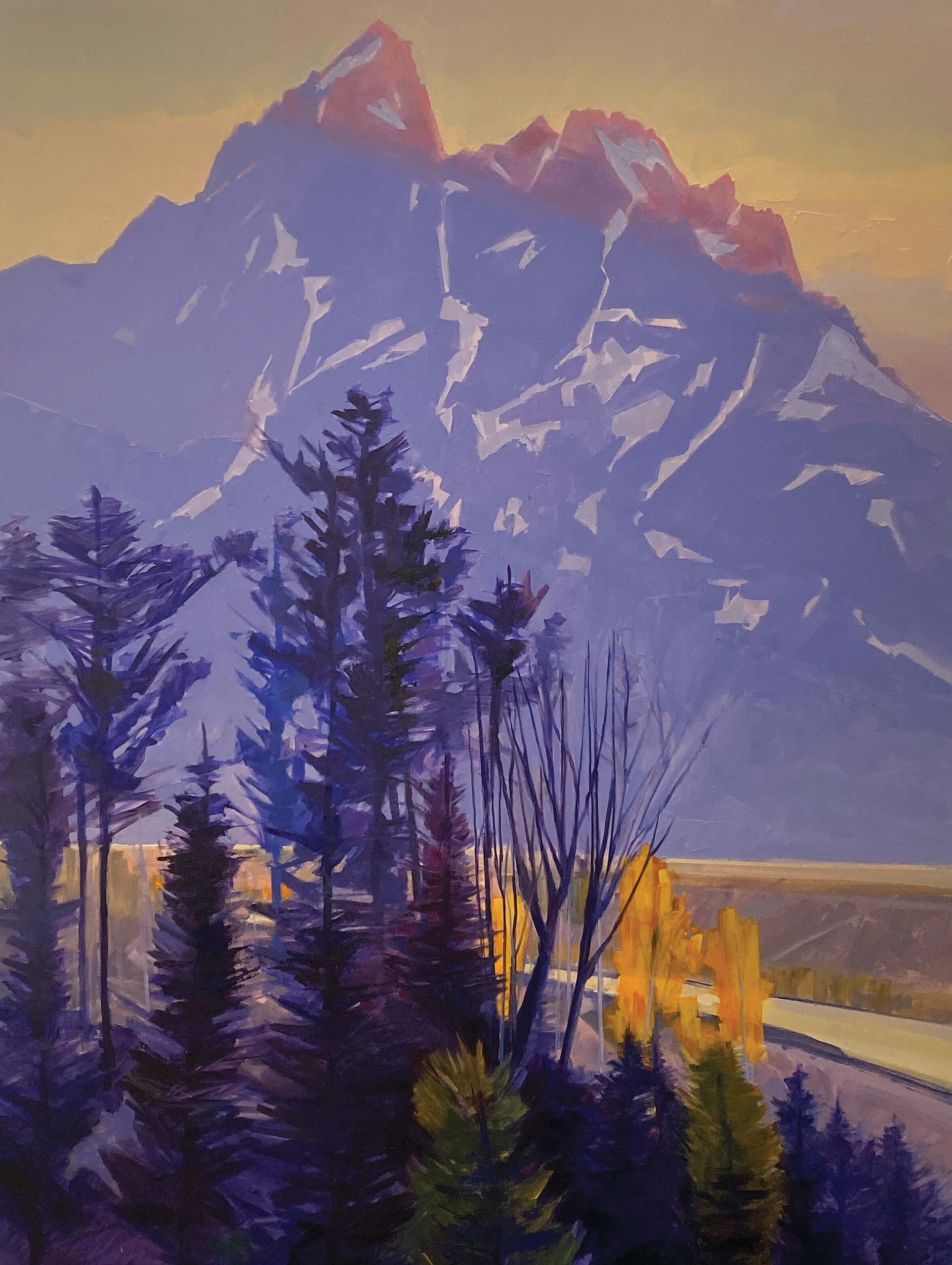
06 Sep Where Memory and Reality Intersect
Martin Blundell’s Contemporary Realism, through formal considerations and out-of-the-box techniques, discovers the new in familiar landscapes. His thickly textured vistas grasp subtle rises and pull slices of light across broken horizons. By incorporating the fleeting nature of memory with fast-changing landscapes, he brings aspects of the human experience into his paintings.
“In simple terms, I describe it as the intersection of reality and memory,” says the Utah-based artist. “When I go out, I do field studies and take photographs. But when I’m in my studio, I’m taking a lot of liberty with color, design and form. It’s my own interpretation of what I see.”
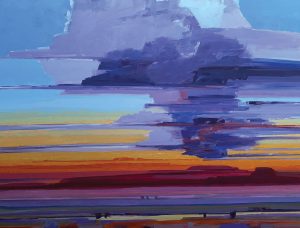
Red Mesa Sky | Oil on Canvas | 36 x 48 inches
Playing with those fine lines that tie emotional recall to experiences, Blundell confronts the photographs of the mind with actuality. Further exploration into this kind of liminal space is enhanced by exquisite colors and on-point textural additions.
“When I started painting again, seriously, I wanted to paint the landscape of the West I’m familiar with and amazed by, but I wanted the realism to be shown in a contemporary way,” he says. “Typically, I’ll start with a loose drawing using a brush, organize the canvas, make adjustments. As I’m organizing, I give myself plenty of latitude.”
Once he gets all the colors down and a good composition on the canvas, he gets rid of all his source materials, photographs, sketches, field studies and all he is left with are his memories of the place.
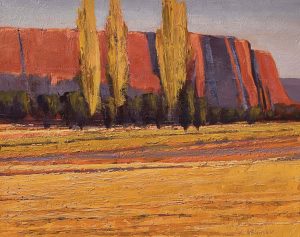
Southwest Farm | Oil on Canvas | 16 x 20 inches
“At that point things begin to happen intuitively, remembering, interpretations, emotions become more important in the second half than in the first,” he says. “The palette knife comes in during the second half.” The palette knife creates a layer of emotional connection. It makes marks, leaves scratches, blurs shapes and brings a visceral quality to his work.
“It works to eliminate the details that might come through with a brush,” Blundell says. “I love that interplay with the viewer figuring out the painting.”
This two-part practice of Blundell’s came to him as a way to develop a type of landscape that was wholly his own. “I’m bringing together something familiar and something new. I’m not relying on the sources, so it’s really being filtered through my own lens.”
It is hard to talk about the West, especially the Southwest, without thinking of the painter Maynard Dixon. Blundell says that Dixon has probably influenced a majority of landscape painters. “He simplified the forms and the colors, creating the essence of the West.” It is that kind of minimalist abstraction with which Blundell experiments.
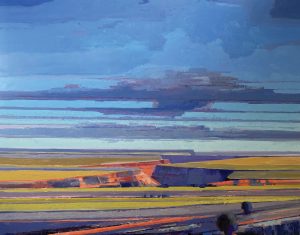
Over the Canyon | Oil on Canvas | 48 x 60 inches
But Blundell goes even further with his art. He looks to the Abstract Expressionist Robert Motherwell’s painting philosophy – make one mark, think about it, make the next mark, and so on – as a way of being present in the work, without preconceived ideas of where the work ends up. “I like that idea of experimentation and I’m not opposed to growing and changing and creating new things for myself. I think an artist needs to push himself, not just repeat what [they’ve] already done.”
Shelly Spence, director of the Grace Renee Gallery, in Carefree, Arizona, has been showing Blundell’s work for two years. “He has a unique look and feel to his artwork,” she says. “It took me a while to find a landscape artist I liked. I love his use of color and the unique way he creates his pieces, with his buildup of paint and the palette play he incorporates.”
Spence also appreciates his ability to shift color. “Landscapes can go terribly wrong easily, but his have gone very well,” she says. “You look at his landscapes, but you don’t see the details. They could be just about anywhere. His paintings are really powerful.”
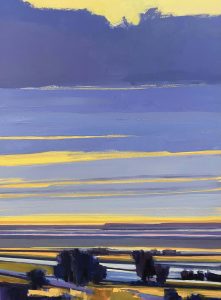
Blue Morning | Oil on Canvas | 48 x 36 inches
Blue Morning, with its sliding scrape of clouds pulling apart, the promise of daybreak over a lavender shadow across the land, and a sturdy stance of trees guarding a slash of river bottom, brings out the vocabulary Blundell uses when talking about the abstracted nature of remembering. His palette knife wipes the elements of brush in the foreground, leaving the just-waking notion of morning.
“Living here in the West, I’m fascinated by moments in time, like sunsets, sunrises, the relationship of mountains and sky, and the natural organization of land and rivers,” he says. “When I travel, I don’t say I’m going out to find an amazing rainstorm in the desert, but I take advantage of the things I see – there’s some serendipity to what I paint.”
He notes the grounded nature of earth and the ephemeral nature of the sky that moves quickly and changes so rapidly. “At that horizon point – storms are interesting to me because they don’t last forever, but the ground beneath them does.”
Sheree Weixler, the gallery manager at the F. Weixler Co., in Salt Lake City, has represented Blundell for five years. “We love the work he does and the colors he uses. He paints the landscapes our clients love and know, but with a fresh perspective, in a more modern way.”
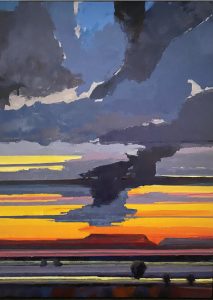
Red Mesa Sundown | Oil on Canvas | 48 x 36 inches
Weixler also pointed to how fast his paintings sell. “We have a small collection of his inventory because it sells so quickly and he gets commission work constantly, which takes time away from the number of paintings we get in the gallery.”
The contemporary perspective on the traditional landscape appeals to Weixler. “It’s really more current. It’s not fussy. And I love the dimensions of his skies, which brings out the openness of our landscape,” something expressed in his piece Above the Canyon, she says. Blundell almost seems to flatten the canyons, only letting slip a glimpse of sunlit sandstone that cannot help but become the focus of the piece. Heavy overhead clouds in dialogue with the wide-open land, hint and whisper like secrets. Through his restrained composition unfolds an abundance of grandeur.
Up until a few years ago, Blundell ran a large design business with 150 employees. Once he retired, he recalled his years in art school and his passion for art.
“I’m so happy that I’m making art now,” he says. “I think I’m only a part of the process – the piece of art finds its own voice – it’s a mysterious but lovely feeling.”






No Comments